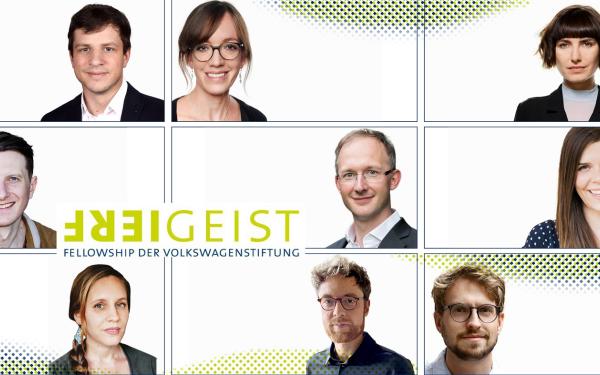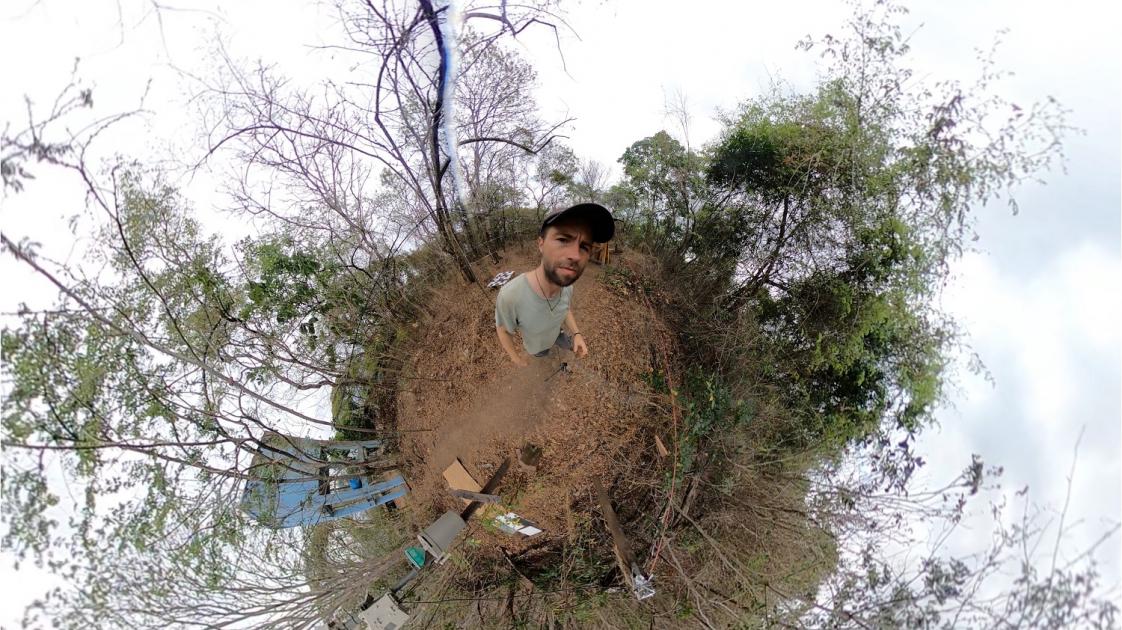
Science Communication: With Virtual Reality to Costa Rica
Together with his team, Matthias Beyer is using drones to establish a method that can be used to measure the water cycles in trees. The results also enable a better understanding of how vegetation is able to adapt to climate change. Additionally, by means of a video project, the research team now also provides detailed insights into the field research in Costa Rica – and into their daily research routine.
Dr. Beyer, could you please tell us something about your research project? What are you working on?
My Freigeist project is called "Isodrones - Resolving the mystery of deep roots". The project deals with deep-rooted vegetation, which exists in almost all the regions and climates on Earth, but about which – due to restricted accessibility – very little is known so far. What we do know, however, is that in many regions, deep-rooted plants play a major role in bridging dry periods. In a healthy mixed forest, for example, deep-rooted trees can shift water into the upper layers of soil, where it becomes available for other tree species. In the context of climate change, which also affects Germany, this is a particularly relevant phenomenon.
The main goal of this project is to be able to detect deep-rooted vegetation (trees, but also shrubs and plant crops) and their impact on ecosystems using drone-based approaches alone. To achieve this goal, we need a long-term, temporally highly disaggregated, and specialized dataset on which to develop appropriate criteria. To this end, we are developing an approach comprising novel methods for measuring stable water isotopes in soils, plants and the atmosphere, which we complement with more classical physiological measurements. Combined with high-resolution images gained from drone flights, we aim to derive indicators that allow us to draw conclusions about the approximate water uptake depth, independent of the tree species studied. Admittedly, this is a very ambitious goal – but this is what a Freigeist Fellowship is all about!
What do you want to achieve with your outreach project?
With our Wisskomm project titled "An international Multimedia WissComm Social Media Campaign", my team and I would like to offer an authentic insight into our everyday research life. In videos on YouTube (Youtube channel of Isodrones) and on our website Isodrones.com, we share large parts of our working, but also personal everyday life. The videos are aimed at a young audience and are intended to give students and young scientists, for example, a realistic impression of what everyday research is like – and at the same time an understanding of complex scientific contexts.
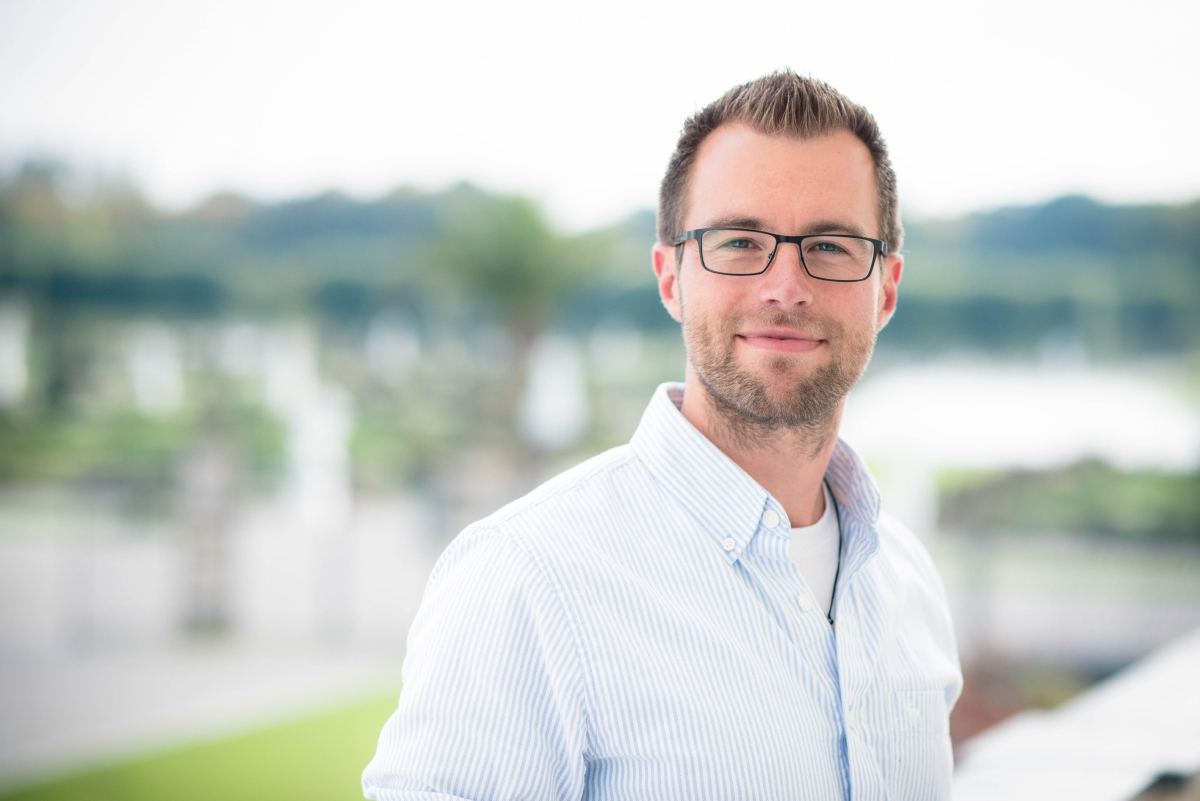
Dr. Matthias Beyer is realizing his research project at the TU Braunschweig. (Photo: Daniel Kunzfeld for VolkswagenFoundation)
How did you implement the Wisskomm project?
We produced a multimedia documentary that follows the main members of the Isodrones project in the following different storylines:
- Kathrin Kühnhammer, PhD student, on her scientific and personal path to her dissertation, which takes her to the dry forest in Costa Rica. There she struggles not only with technical problems, but also with personal challenges. Kathi also brings to life the topics of women in science and feminism.
- Malkin Gerchow, also a doctoral student, but a mechatronics engineer and not a natural scientist, searches for technical solutions to scientific problems, which presents him with some serious challenges, but is also great fun – he is our "MacGuyver," so to speak.
- And my humble person: As project manager of Isodrones, I am responsible for everything that happens in the project. And that is my challenge – both scientifically and personally. I find myself in constant self-doubt – where do I want to go, am I good enough? Do I want to work permanently for 50 hours a week, or more? Should anyone work that much at all? What is the best way to combine life and work?
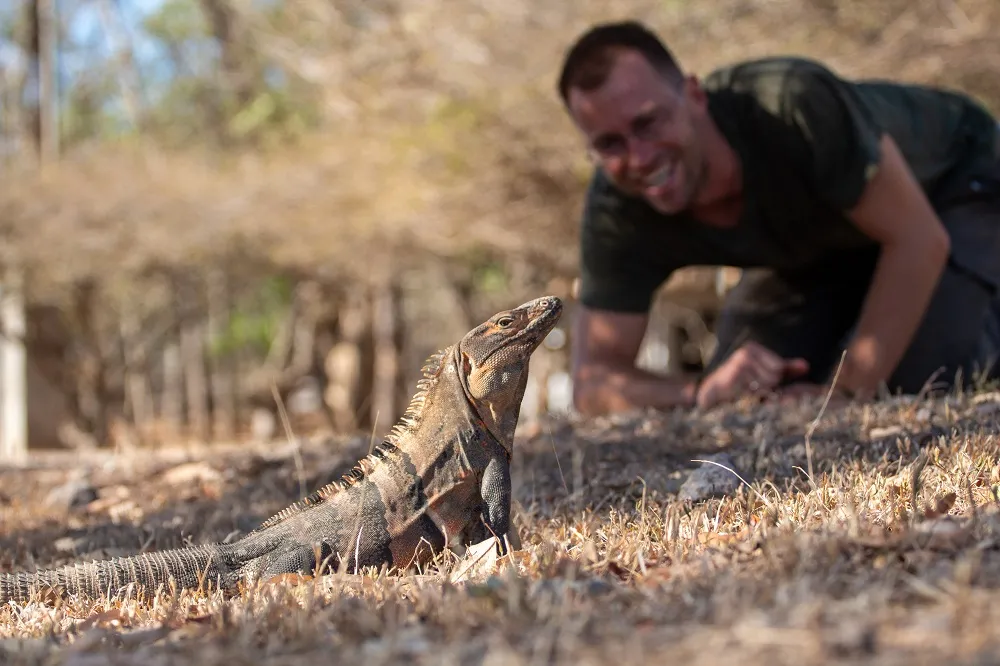
Surprise guest at the research camp: a black iguana. (Photo: Isodrones)
With the possibility to gain an insight into the lives of these 3 persons, we hit the nerve of the time pretty well, I think. In addition to YouTube, we also publish the content on Twitter and Instagram.
Beyond that, how do you provide insights into your research?
In addition, we have produced one of the first, if not the very first, "Interactive Study Sites": We present our main research location, a dry forest in northwestern Costa Rica, in a 360° virtual reality. Equipped with VR goggles, users can explore what we are doing – partly guided, partly freely and interactively – look at measuring devices and our monitoring setup, view data such as the transpiration rates of individual trees directly visualized and even experience a 360° drone flight. In addition, they listen to recordings that make our research tangible and understandable. The whole thing is presented at a number of events – including an international workshop in Italy.
We shot all the 360° videos ourselves and are of course evaluating the benefits: What does this new communicative territory offer for science communication? Is such content equally helpful for scientists and lay persons? Can we make our highly advanced technical methods understandable and tangible to the general public? Will people be able to understand their usefulness in practice? All this is a huge experiment; for us as researchers, but also for the media professionals we work with.
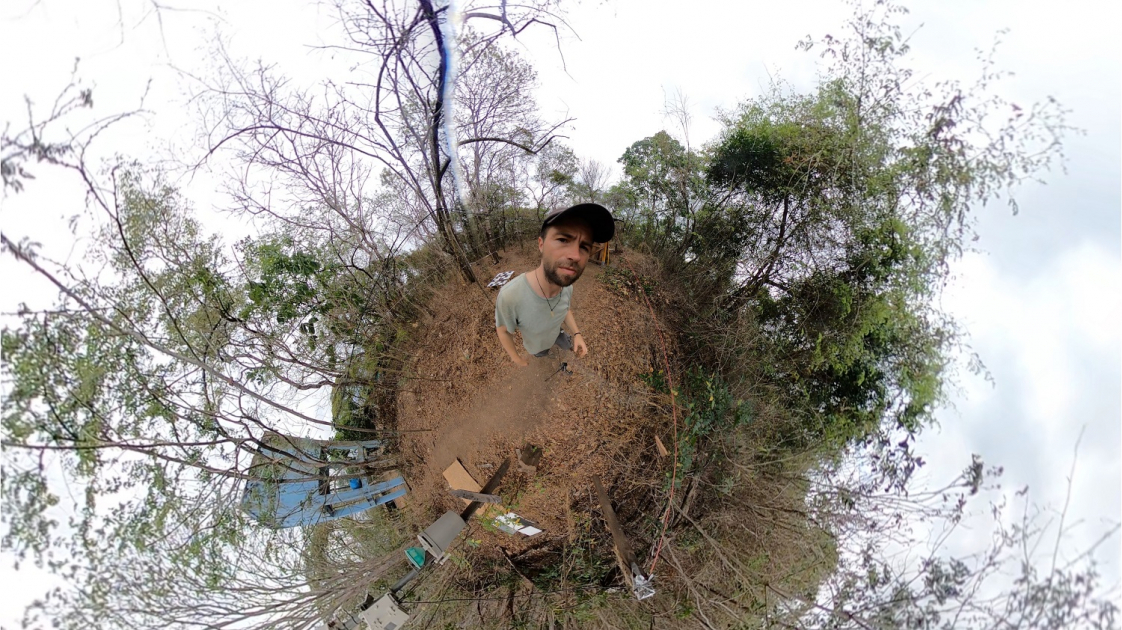
360 degree recording of the weather station in the research camp in Costa Rica. (Photo: Isodrones)
How has the pandemic impacted on the project?
Unfortunately, there have been some massive restrictions in both my Freigeist project as well as the science communication project – I think each of us has our own experiences of how the pandemic impacted our daily work and life. For example, we were unable to carry out planned fieldwork in Costa Rica and had to postpone various field trials. In retrospect, however, I believe that our WissKomm project actually benefited from this involuntary break: We used the situation to carry out an evaluation with external media experts and introduce changes in order to communicate our work even more purposefully and clearly. The evaluation led to a sharpening of the topics as well as the content and communication channels used.
How did you develop the Wisskomm project?
In the course of several workshops held with the participation of our Creative Director Christoph Nick from c-Studios and external media experts, we first sharpened the goal and target groups. To do this, we created so-called "personas" that represent our target groups: Junior researchers and our immediate science community. These different target groups naturally move on different channels and are interested in differently presented content and formats. Therefore, the next steps were to develop a content strategy (How do we reach whom with what?), a social media channel-mix (Who do we reach and where?), and the definition of genres, formats, content. These are things a scientist would normally never give a thought to! But it is essential for such a large project. In the next step, we then created an editorial schedule, i.e., when do we post what and how often, and what is the specific content. Working out a workflow for producing the different content took a lot of time, but we've made huge progress and are now slowly getting into a workflow that, little by little, feels less labor-intensive for everyone concerned and more organic overall.
How did you come up with the idea for the project?
The initial spark came from the visit of a film team from ARTE, which visited us during fieldwork in Namibia while I was writing my doctoral thesis. Parallel to the professional film work, we shot a 45-minute semi-professional film about our project and the field work. I greatly enjoyed explaining to people in simple terms what we were actually doing. Moreover, quite a lot of people watched these films and the feedback was consistently positive. Since we started with Isodrones, I've tried to continue on this path, which is to explain complex issues in a simple and tangible way and thereby make research more accessible, to be authentic – and to refocus the collective consciousness onto our planet. In combination with my penchant for surfing VLOGs, I came up with the idea for the WissKomm campaign.
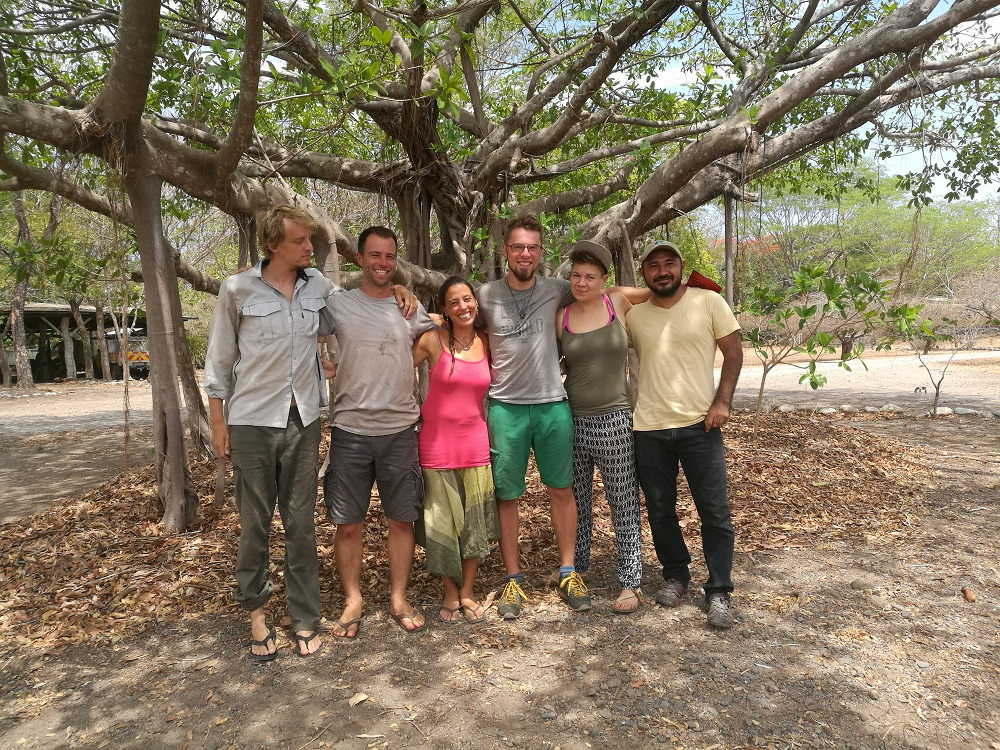
The research team (from left): Malkin Gerchow, Dr. Matthias Beyer, Ana Claudia Callau Poduje, Adrian Dahlmann, Kathrin Kühnhammer, Alberto Iraheta. (Photo: Isodrones)
Is the time required for the Wisskomm project compatible with your research work?
To be quite honest with you, it takes up an incredible amount of time, and we all rather underestimated what was involved. In principle, it's like having a whole new research project that has to be coordinated from start to finish. Planning, creating ideas and content, solving conflicts; the beginning was already rather chaotic and thwart with difficulty. But now, after half a year, it boils down to getting on with the daily work and recognizing what is usable and interesting WissKomm content for the respective target groups. For us, this was a long and sometimes painful process. But once you have internalized this and established clear workflows, it naturally gets better and better.
What kind of support did you get on board?
We have two social media managers and a creative director who do a lot of the technical work and are incredibly passionate about our project. I can't praise their work enough! You shouldn't underestimate the effort involved, so be sure to get professional media experts on your side right from the start. And that's the whole dilemma: I don't see how the things we are currently implementing can be integrated into a "normal" research project. Both time and cost are hardly compatible with cutting-edge research – but I suppose the entire field of science communication is faced with the same problem.
What advice would you give to other scientists who want to start a similar outreach project?
I would say: Just do it! Do what feels good! And don't get into too much of a twist. That's the only way to convey authenticity and to reach people. As with all things, you learn through experience. All too often, researchers underestimate their own capability and get bogged down in perfectionism and self-doubt. Not doing something just because you think no one might be interested is the wrong approach.
Beyond that – and I think this is particularly important for scientists – I can only advise sticking to the 80/20 rule – excessive perfectionism is simply not effective in the fast-moving world of social media and will soon wear you out. At the same time, of course, you have to feel good about what you are doing. There's little point in undertaking a WissKomm project if you don't actually have any real interest in it and are simply trying to generate "impact". And then, as already mentioned, you should definitely get professional support – no scientist can possibly have all the requisite know-how up their sleeve.
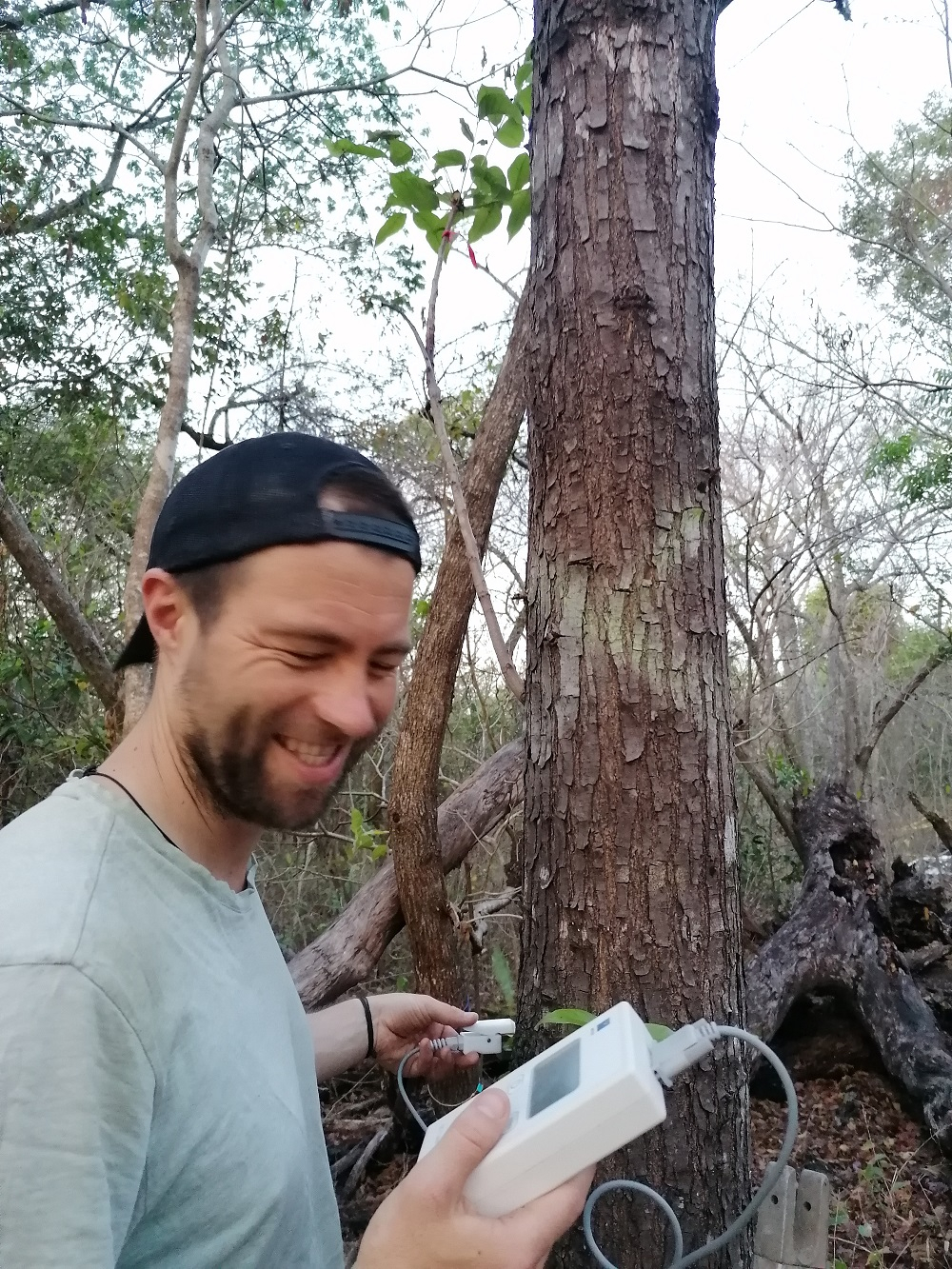
Matthias Beyer measures the water flow on a tree in the research camp. (Photo: Isodrones)
What surprised you the most during production?
I found it surprising how good the feedback on the products has been so far. You're always your own biggest critic – so it's all the nicer to get positive feedback on the content. It was a big surprise to see how many people contact us, give feedback, offer support and also put detailed questions about the project.
What do you find so interesting about science communication – what drives you to put in all this extra effort?
I find it a useful learning effect to do a project in a field other than pure science. It makes a lot of sense to me, even as a scientist, to think about how we can make our sometimes highly complex worlds of ideas understandable to the average citizen. For example, I love talking to foresters and thinking about how their incredible knowledge can be useful for scientific applications. Creating knowledge is not a one-way street! Without this insight or mindset, we scientists will never find a wider audience or bring our findings to the decision-making table. It is not about being popular or famous. It's about ensuring that exciting and important research results find a faster way to a wider audience than before – and I think our science communication project is a very good tool for this.


